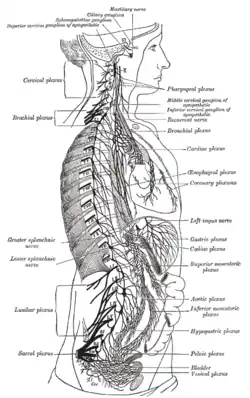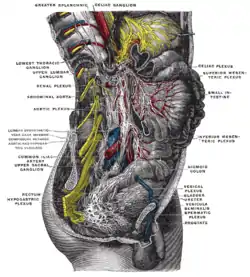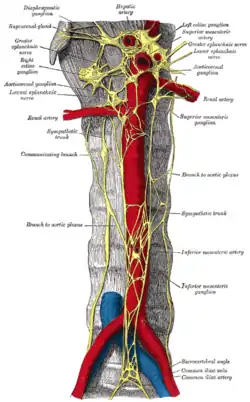Inferior hypogastric plexus
The inferior hypogastric plexus (pelvic plexus in some texts)[1] is a network (plexus) of nerves that supplies the organs of the pelvic cavity. The inferior hypogastric plexus gives rise to the prostatic plexus in males and the uterovaginal plexus in females.[2]
| Inferior hypogastric plexus | |
|---|---|
 The right sympathetic chain and its connections with the thoracic, abdominal, and pelvic plexuses. (Pelvic plexus labeled at bottom right.) | |
 Lower half of right sympathetic cord. (Hypogastric plexus labeled at bottom left.) | |
| Details | |
| Identifiers | |
| Latin | plexus hypogastricus inferior |
| TA98 | A14.3.03.048 |
| TA2 | 6715 |
| FMA | 6643 |
| Anatomical terms of neuroanatomy | |
The inferior hypogastric plexus is a paired structure, meaning there is one on the left and the right side of the body. These are located on either side of the rectum in males, and at the sides of the rectum and vagina in females. For this reason, injury to this structure can arise as a complication of pelvic surgeries and may cause urinary dysfunction and urinary incontinence. Testing of bladder function is used in that case to show a poorly compliant bladder, with bladder neck incompetence, and fixed external sphincter tone.[3]
Structure
The plexus is formed from:
- a continuation of the superior hypogastric plexus on either side, at the Sacrum Promontory in the interiliac triangle. At this location, the presacral nerve sits in the middle in only 25% of people and is more commonly present on the left.[4]
- sacral splanchnic nerves, from the sympathetic trunk.
- pelvic splanchnic nerves (from the second, third, and fourth sacral nerves) also contribute parasympathetic efferent fibers to the plexus.
From these plexuses numerous branches are distributed to the viscera of the pelvis.
They accompany the branches of the internal iliac artery.
It is the source for the middle rectal plexus, vesical plexus, prostatic plexus, and uterovaginal plexus.[5]
Additional images
References
![]() This article incorporates text in the public domain from the 20th edition of Gray's Anatomy (1918)
This article incorporates text in the public domain from the 20th edition of Gray's Anatomy (1918)
- Yokochi, Chihiro; Rohen, Johannes W. (2006). Color Atlas of Anatomy: A Photographic Study of the Human Body. Hagerstown, MD: Lippincott Williams & Wilkins. p. 346. ISBN 0-7817-9013-1.
- "Sacral Plexus, Pelvic Diaphragm". Archived from the original on 2015-10-07.
- CAMPBELL-WALSH UROLOGY, ed 11. p. 1781.
- Ramirez C, Donnellan N. (2017). "Pelvic denervation procedures for dysmenorrhea". Curr Opin Obstet Gynecol. 29 (4): 225–230. doi:10.1097/GCO.0000000000000379. PMID 28683027. S2CID 205607600.
{{cite journal}}: CS1 maint: uses authors parameter (link) - Jeyarajah S, King A, Papagrigoriadis S (2007). "Faecal incontinence as presentation of an ependymomas of the spinal cord". World J Surg Oncol. 5: 107. doi:10.1186/1477-7819-5-107. PMC 2034572. PMID 17894884.
External links
- Autonomics of the Pelvis - Page 5 of 12 anatomy module at med.umich.edu
- Autonomics of the Pelvis - Page 6 of 12 anatomy module at med.umich.edu
- figures/chapter_32/32-6.HTM: Basic Human Anatomy at Dartmouth Medical School
- posteriorabdomen at The Anatomy Lesson by Wesley Norman (Georgetown University) (posteriorabdmus&nerves)
